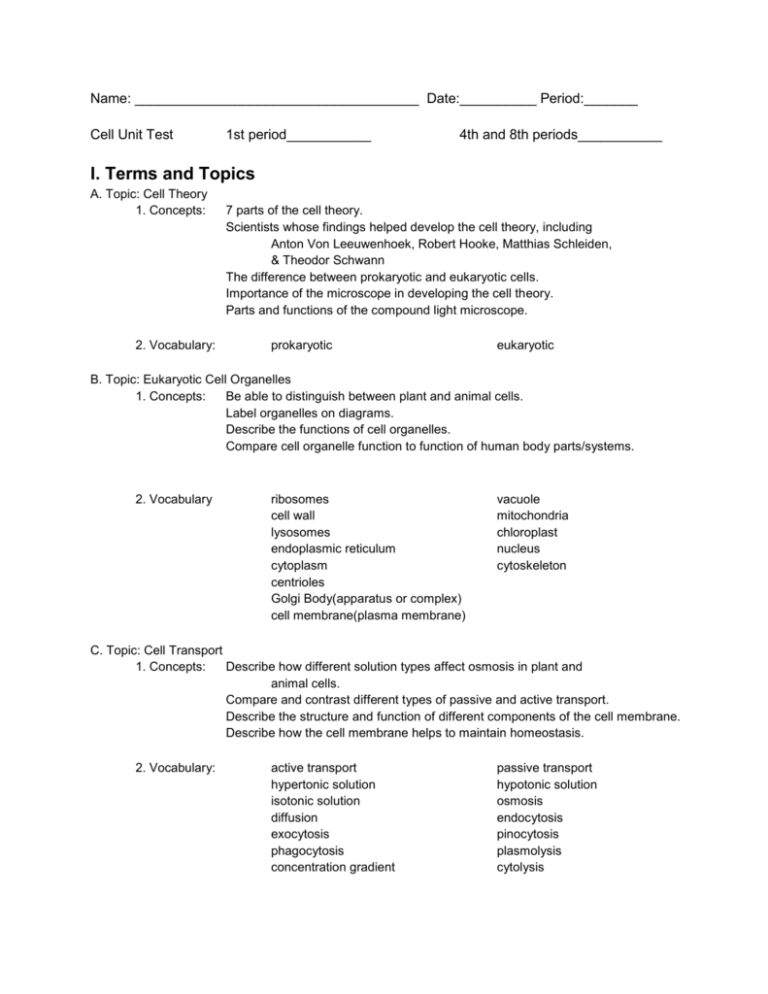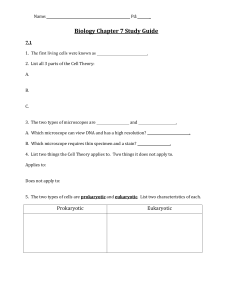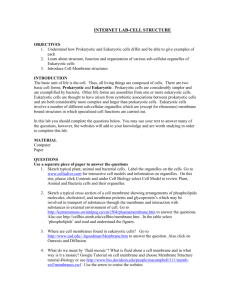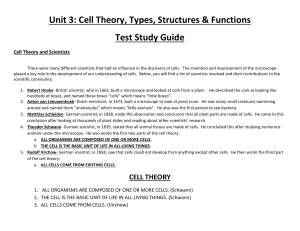Blank Review Packet
advertisement

Name: _____________________________________ Date:__________ Period:_______ Cell Unit Test 1st period___________ 4th and 8th periods___________ I. Terms and Topics A. Topic: Cell Theory 1. Concepts: 2. Vocabulary: 7 parts of the cell theory. Scientists whose findings helped develop the cell theory, including Anton Von Leeuwenhoek, Robert Hooke, Matthias Schleiden, & Theodor Schwann The difference between prokaryotic and eukaryotic cells. Importance of the microscope in developing the cell theory. Parts and functions of the compound light microscope. prokaryotic eukaryotic B. Topic: Eukaryotic Cell Organelles 1. Concepts: Be able to distinguish between plant and animal cells. Label organelles on diagrams. Describe the functions of cell organelles. Compare cell organelle function to function of human body parts/systems. 2. Vocabulary ribosomes cell wall lysosomes endoplasmic reticulum cytoplasm centrioles Golgi Body(apparatus or complex) cell membrane(plasma membrane) vacuole mitochondria chloroplast nucleus cytoskeleton C. Topic: Cell Transport 1. Concepts: Describe how different solution types affect osmosis in plant and animal cells. Compare and contrast different types of passive and active transport. Describe the structure and function of different components of the cell membrane. Describe how the cell membrane helps to maintain homeostasis. 2. Vocabulary: active transport hypertonic solution isotonic solution diffusion exocytosis phagocytosis concentration gradient passive transport hypotonic solution osmosis endocytosis pinocytosis plasmolysis cytolysis II. Vocabulary: Fill in the statements below with the correct term. A. ____________________ cells are composed of a cell membrane, a nucleus and various membrane bound organelles. B. The ______________________ describes the complex structure of the eukaryotic cell membrane. C. Cells were first named when______________________ observed cork slices under the microscope. D. During diffusion, particles travel down the ______________________ from an area of high concentration to an area of low concentration. E. Plant cells contain large______________________, which store water and minerals. F. A solution that has more dissolved solutes than a cell is considered________________. G. ___________________ are the location where coded messages from the nucleus are used to produce proteins. H. Bacteria are simple, single celled organisms composed of __________________ cells. I. The plasma membrane of a cell is considered_____________________, because it allows some materials to pass into or out of the cell. J. ___________________ are two small structures found only in animal cells, that are involved in cell division. K. If animal cells are are placed in a hypotonic solution, they will burst or undergo the process of____________________. L. The ____________________microscope allows observation of cells using two lenses to increase magnification. M. The _____________________ modifies, detoxifies, and carries substances through the cell, and can be rough or smooth. N. Endocytosis can involve the taking in of dissolved particles, called ___________________, or taking in larger solid particles, known as _____________________. O. The ___________________ can be described as “bean” shaped, and is the site where ATP is produced. P. Homeostasis is maintained by the ______________________, which helps to regulate what enters and leaves the cell. Q. A plant cell will contain many____________________; small green structures where photosynthesis takes place. R. Most of the DNA in a cell is found in the ______________________. S. _______________________ and ________________________ discovered plant and animal cells. III. Short Answer Questions: Answer each question using complete sentences. A. What invention allowed cell theory to develop? B. Compare and contrast eukaryotic and prokaryotic cells. C. Describe the function of proteins and carbohydrates in the cell membrane. D. Compare and contrast animal and plant cells. E. Compare and contrast passive and active transport over the cell membrane(be sure to use the term concentration gradient). F. How do hypertonic, hypotonic, and isotonic solutions compare based on solute concentration? G. Compare 4 eukaryotic cell organelles to systems/structures in the human body. IV. Diagrams: Label each of the following diagrams. _____________________Cell ______________________Cell What is the magnification of this microscope?____











